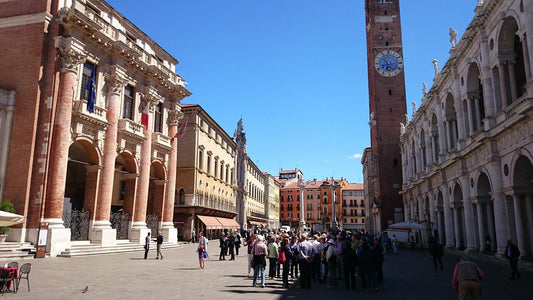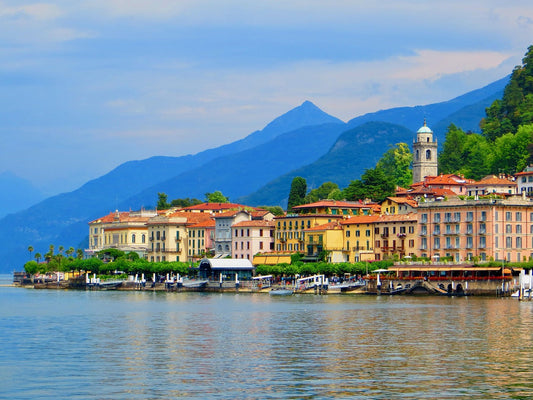
Die Geschichte des Parmigiano Reggiano: der italienische König unter den Käsesorten
Was ist Parmigiano Reggiano?

Parmigiano Reggiano, liebevoll bekannt als der "König der Käsesorten", ist ein gefeierter Hartkäse mit ausgeprägten körnigen Texturen und einem reichen, komplexen Aromenprofil. Er wird ausschließlich in einem festgelegten Gebiet produziert, das die Provinzen Parma, Reggio Emilia, Modena und Teile von Bologna und Mantova in Italien umfasst. Die Kühe, die die Milch für diesen außergewöhnlichen Käse liefern, werden mit lokalen Futtermitteln gefüttert, was einen einzigartigen Geschmack gewährleistet, der das Terroir der Region widerspiegelt. Strenge Vorschriften regeln die Käseproduktion und verbieten die Verwendung von Silage, fermentierten Lebensmitteln und tierischen Futtermitteln in der Ernährung der Kühe, was die höchste Milchqualität sichert.
Der Produktionsprozess von Parmigiano Reggiano beginnt mit der Morgenmilch, die mit der Milch des vorherigen Abends kombiniert wird, und in große, glockenförmige Kupferkessel gegossen wird. Ungefähr 550 Liter Milch sind erforderlich, um ein einziges Rad Parmigiano Reggiano herzustellen. Die Milch wird dann durch die Zugabe von tierischem Lab und natürlicher Molke, die aus früherer Käseherstellung gesammelt wurde, natürlich gerinnen gelassen.
Sobald die Milch geronnen ist, wird der Bruch mit einem traditionellen Werkzeug, das als "Spino" bekannt ist, in winzige Körner zerlegt. Dieser Bruch wird dann auf etwa 55 Grad Celsius erhitzt, wodurch die Granulate zusammen sinken und eine feste Masse bilden. Nach etwa 50 Minuten entnimmt der Käsemacher die Masse, die dann in zwei identische Räder geteilt wird. Jedes Rad wird in Leinenstoff gewickelt und in Formen gelegt, wobei es eine einzigartige Identifikationsplatte erhält, die einen alphanumerischen Code trägt.
Nachdem die Räder durch Osmose gesalzen wurden, durchlaufen sie einen Mindestalterungsprozess von 12 Monaten. Während dieser Zeit bewerten Experten den Käse, um sicherzustellen, dass er die strengen Kriterien für die Bezeichnung Parmigiano Reggiano erfüllt. Nur die Räder, die die Qualitätsbewertung bestehen, dürfen diesen prestigeträchtigen Namen tragen, während diejenigen, die dies nicht tun, ihrer Identifikation beraubt werden.

Ein Käse, der im Mittelalter geboren wurde
Die faszinierende Geschichte des Parmigiano Reggiano reicht bis ins Mittelalter zurück, als Cistercienser und Benediktiner versuchten, einen lang haltbaren Käse zu produzieren, der sich zur Konservierung eignete. Durch die Nutzung von Salz aus den nahegelegenen Salinen von Salsomaggiore und der Milch ihrer Rinder gelang es diesen Mönchen, einen Käse zu schaffen, der die Zeit überdauern konnte.
Die frühesten dokumentierten Beweise für den kommerziellen Handel mit Parmigiano Reggiano erscheinen 1254 in Genua, wo er als "caseus parmensis" oder "Käse aus Parma" bezeichnet wurde. Im 14. Jahrhundert hatte sich der Käsehandel erheblich auf Regionen wie Romagna, Piemont und Toskana ausgeweitet und erreichte die Küstenmärkte des Mittelmeers. Die 1400er markierten eine Phase des wirtschaftlichen Wachstums und einer erhöhten Produktion in Emilia, da lokale Feudalherren und Abteien um die Steigerung der Käseproduktion konkurrierten. In dieser Zeit wuchsen die Radgrößen, und einige wogen bis zu 18 Kilogramm.
Im 16. Jahrhundert entstanden spezialisierte Käseherstellungszentren, die als Turnario-Käsereien bekannt sind, in denen Milchbauern gemeinsam Milch von ihren eigenen Herden sowie von benachbarten Höfen verarbeiteten. Dieser gemeinsame Aufwand verbesserte nicht nur die Produktivität, sondern wurde auch zu einem Grundpfeiler der lokalen Wirtschaft.

Anerkennung und Schutz
Im 17. Jahrhundert führte die steigende Nachfrage nach Parmigiano Reggiano zu Bedenken hinsichtlich der Echtheit des Produkts, was Duke Ranuccio I Farnese von Parma dazu veranlasste, den Namen des Käses 1612 offiziell anzuerkennen. Dieser Akt legte die Grenzen fest, aus denen authentischer Parmigiano Reggiano bezogen werden konnte, und markierte den Beginn des geschützten Ursprungsbezeichnung (DOP) Konzepts.
Obwohl der kontinuierliche Krieg im Herzogtum Parma und Modena im 18. Jahrhundert Herausforderungen für die Käseproduktion darstellte, blieben die traditionellen Methoden zur Herstellung von Parmigiano Reggiano weitgehend unverändert. Die frühen 1900er Jahre brachten Innovationen wie die Verwendung von natürlichen Molke-Startern und Dampferhitzung mit sich, die den Produktionsprozess modernisierten.
Am 27. Juli 1934 vereinigten sich Vertreter von Molkereien aus den Produktionsregionen, um eine Herkunftsmarke für ihren renommierten Käse zu etablieren. Die Nachkriegszeit erlebte eine Wiederbelebung der Beliebtheit von Parmigiano Reggiano, unterstützt durch die Stresa-Konferenz von 1951 und nachfolgende italienische Gesetze zur Förderung von Herkunftsbezeichnungen, was schließlich zur Gründung des heutigen Consorzio del Formaggio Parmigiano Reggiano führte.
Bis 1996 erhielt Parmigiano Reggiano auf europäischer Ebene die Anerkennung als DOP, was seinen Status festigte und Schutz gegen Nachahmung und Betrug gewährte. Diese Bezeichnung ist entscheidend für den Schutz des Erbes von Parmigiano Reggiano, da es einer der am stärksten gefälschten Käse der Welt ist.

Abschluss
Parmigiano Reggiano ist mehr als nur ein Käse; es ist ein kulinarisches Erbe, das Jahrhunderte von Tradition, Handwerkskunst und Hingabe an die Qualität repräsentiert. Von seinen mittelalterlichen Anfängen bis zu seiner zeitgenössischen Anerkennung als DOP spiegelt dieser exquisite Käse die Identität und Kultur seiner Region wider. Ob gerieben über Pasta, kombiniert mit einem feinen Wein oder pur genossen, Parmigiano Reggiano fasziniert weiterhin Feinschmecker weltweit und steht als Zeugnis des reichen gastronomischen Erbes Italiens.






